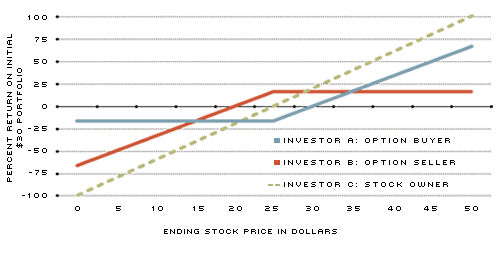Ask An Economist
Warren Buffett described some derivatives as “financial weapons of mass destruction.” In light of recent events on Wall Street, does The Regional Economist agree? —Christopher Schlie, accounting student at the University of Cincinnati
Yes, derivatives are financial weapons of mass destruction. Firms and individual investors can lose a lot of money very quickly. But you can also lose everything you invest in a single day in stocks and bonds. For that matter, any other kind of asset—including your house, car or a painting—can decline rapidly in value, too. Yet, the vast majority of derivatives traders and end-users do not complain, either because the contracts are useful in hedging risks or because they have consciously chosen to speculate using derivatives.
Why did Mr. Buffett make a special point about derivatives being financial weapons of mass destruction? Most likely, he meant to highlight at least three features of derivatives that distinguish them from other assets: 1) they contain a great deal of “implicit” leverage, 2) they often have very complex payoff patterns and 3) they lack transparency when they are traded over the counter (OTC), or away from an organized exchange.
Leverage. A futures contract or an option contract (two important types of derivatives) automatically leverages, or multiplies, an investor’s exposure to the underlying risk. The price of an option on a share of stock, for example, can be much lower than the price of the stock itself, while the potential profit or loss per share is the same in dollar terms. Given the smaller initial investment, the option contract multiplies the gain or loss in percentage terms.
To illustrate, suppose there are three investors, A, B, and C, each with $30 in cash. Investors B and C each buy a share of a stock for $25. Investor A pays investor B $5 for a call option that gives A the right to buy a share of the stock currently worth $25 from B at that price either today or tomorrow.
|
Portfolios at end of first day
|
Cash
|
Stock
|
Options
|
Total
|
|
Investor A
|
$25
|
$5
|
$30
|
|
|
Investor B
|
$10
|
$25
|
–$5
|
$30
|
|
Investor C
|
$5
|
$25
|
$30
|
If the stock price goes up $10 tomorrow, to $35, A can acquire a share for $25 by exercising his option. A would make a net gain of $5 (after deducting the $5 cost of the option)—not bad for a $5 investment. Investors B and C had to invest $25 to earn net gains of $5 and $10, respectively.
|
Portfolios if stock goes up to $35
|
Cash
|
Stock
|
Options
|
Total
|
|
Investor A
|
$35
|
$35
|
||
|
Investor B
|
$35
|
$35
|
||
|
Investor C
|
$5
|
$35
|
$40
|
Complex payoffs. To see how complex payoff patterns can be on options, consider some other possible stock-price changes. If the stock price stays the same or falls, investor A will not exercise his call option, letting it expire worthless. Investor B will suffer any decline in stock price, but would get to keep the $5 option premium paid by Investor A. Investor C simply would suffer the stock-price decline.
|
Portfolios if stock goes down to $15
|
Cash
|
Stock
|
Options
|
Total
|
|
Investor A
|
$25
|
$25
|
||
|
Investor B
|
$10
|
$15
|
$25
|
|
|
Investor C
|
$5
|
$15
|
$20
|
|
Portfolios if stock goes down to $5
|
Cash
|
Stock
|
Options
|
Total
|
|
Investor A
|
$25
|
$25
|
||
|
Investor B
|
$10
|
$5
|
$15
|
|
|
Investor C
|
$5
|
$5
|
$10
|
Because the stock price could go up quite a bit as well as down, consider a $20 stock-price increase.
|
Portfolios if stock goes up to $45
|
Cash
|
Stock
|
Options
|
Total
|
|
Investor A
|
$45
|
$45
|
||
|
Investor B
|
$30
|
$30
|
||
|
Investor C
|
$5
|
$45
|
$50
|
Investor C appears to have the riskiest portfolio while the option traded between Investors A and B appears to have damped down the volatility of their portfolios. Yet the option-trading investors have portfolios with complex relationships to the stock price itself, as the chart below illustrates. Investor C’s portfolio returns rise and fall smoothly with increases and decreases in the stock price. Investors A and B experience portfolio returns that are much more difficult to describe—they are more like hockey sticks than straight lines.
Figure 1
Portfolio Payoffs

Lack of transparency. The amount of derivatives trading that occurs on an organized exchange such as the Chicago Mercantile Exchange is public information. In OTC derivatives markets, there is no central counterparty and no reporting requirement. Therefore, there is no way to know how many contracts of a particular type actually are being traded at any given time. In some cases, the amount of derivatives trading may far exceed the amount of trading in an underlying asset. Because derivatives contracts are “zero-sum” (for every winner, there is a loser), they can be created without limit and, in some cases, without the consent of the issuer of a security on which the derivatives are based. The result is that the OTC derivatives markets are not very transparent and, therefore, can yield some nasty surprises.
So Warren Buffett is absolutely correct that derivatives are financial weapons of mass destruction. Like real weapons, they can be extremely damaging if used imprudently. Fortunately, most derivatives traders and end-users are fully aware of the danger.
Endnote
- See pp. 13-15 of Berkshire Hathaway’s 2002 Annual Report at www.berkshirehathaway.com/2002ar/2002ar.pdf. [back to text]
Views expressed in Regional Economist are not necessarily those of the St. Louis Fed or Federal Reserve System.
For the latest insights from our economists and other St. Louis Fed experts, visit On the Economy and subscribe.
Email Us


